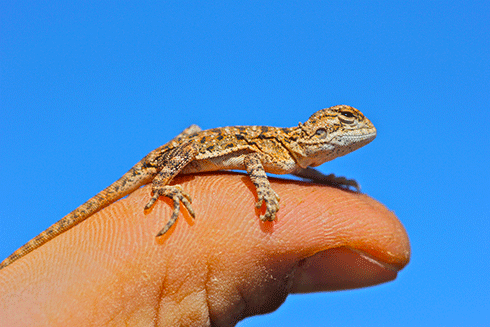
|
Published: 14 October 2013
Protected wheatbelt reserve proves valuable refuge for native species
After 10 years of conservation management, Bush Heritage Australia’s Charles Darwin Reserve near Wubin in Western Australia has recorded 61 per cent of all the bird species listed in the Atlas of Living Australia for the Avon Wheatbelt Merriden bioregion; 52 per cent of local reptiles; 45 per cent of mammals; 55 per cent of frogs; and 35 per cent of plants.

|
|
A western netted dragon discovered during the fauna survey. Credit: Tim Doherty
|
According to Bush Heritage, it is this high concentration of species that makes this former sheep station Australia’s most significant refuge for Avon Wheatbelt bioregion flora and fauna.
The reserve fills a gap in the National Reserve System by protecting native animals and plants, including endangered species such as the malleefowl in one of the most under-represented bioregions in Australia.
Charles Darwin Reserve’s botanical diversity includes salmon gum, York gum and callitris woodlands, acacia shrubland, chenopod herbfield and granite outcrops with fringing vegetation – providing the necessary range of vegetation to support 120 bird species, including the Major Mitchell cockatoo, regent parrot and red-tailed black cockatoo.
Intensive surveying in the shrubland and woodlands has revealed 64 species of reptiles and 17 native mammals, including four species of dunnarts (small carnivorous marsupials) and nine micro-bats. The reserve also supports 19 priority plant species that are listed under the WA Wildlife Conservation Act, including Acacia cerastes.
Falling largely within the internationally recognised Southwest Botanical Province biodiversity hotspot, Charles Darwin Reserve is a melting pot of native species because it also straddles the more arid Eremean Province to its north.
‘Some of the species we’ve discovered on Charles Darwin Reserve include a gecko not only new to the reserve but representing a significant extension to its known habitat range,’ says Dr Jim Radford, Bush Heritage’s director of science.
Charles Darwin Reserve has also been the site of a Federal Government species discovery initiative that found 21 new-to-science species, including a rare skipper butterfly and a new species of pseudoscorpion.
‘Since 2003, we’ve worked with our research partners, neighbours, scientists and numerous volunteers to manage, monitor and reduce a range of threats, from invasive weeds and feral animals to bushfires and drought in order to protect this significant biodiversity refuge,’ says Reserve Manager, Luke Bayley.
Bush Heritage Australia purchased the 68 481-hectare property in 2003 with help from Chris Darwin, the great-great grandson of naturalist, Charles Darwin, after whom the property is named.
Chris saw it as an opportunity to address Darwin’s only regret – a desire to have done more for his fellow creatures.
Source: Bush Heritage Australia



